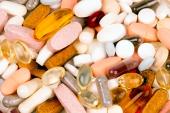Some Daylight for Vitamin D? New Analysis Hints at Small CVD Benefit
Although the findings might be play of chance, the data do warrant combined analyses with other trials, researchers say.

Authors of a new analysis from the large, randomized D-Health study say their findings don’t rule out the possibility that vitamin D might reduce the risk of cardiovascular events, particularly MI in elderly patients.
The relative reduction in risk of major cardiovascular events was small—and didn’t meet statistical significance for the primary endpoint studied—but investigators saw enough in the data that they believe the conclusions about vitamin D’s lack of benefit in CVD prevention are “premature.”
Those conclusions, notably, come from two prior long-running, randomized controlled trials, which together looked at more than 30,000 patients and concluded that the supplement had no beneficial effects for the heart.
“It’s important to emphasize that our results are not statistically significant, [but] they were highly suggestive,” senior investigator Rachel E. Neale, PhD (QIMR Berghofer Medical Research Institute, Queensland, Australia), told TCTMD. “We are acutely aware that these findings could be chance. Having said that, they kind of make sense. In terms of advising people—I have been asked a lot about that these past couple of days—would I recommend people take a vitamin D supplement on the basis of these results? Maybe. It depends on the individual threshold people want for that evidence.”
If people want “absolute, definitive proof,” they probably won’t be inclined to take vitamin D, she said. However, at 2,000 IU per day, or 60,000 IU monthly as used in the trial, vitamin D is safe, relatively inexpensive, “and if people want to take it on the off chance it will do them some good, I don’t think there’s any harm in making that decision,” Neale added.
While researchers believe these data, published this week in the BMJ, offer a glimmer of sunlight for vitamin D, others don’t think the results are strong enough to alter the current consensus that supplementation doesn’t lower the risk of developing CVD.
“I think these are likely to be chance findings in the context of the totality of the evidence,” JoAnn Manson, MD, DrPH (Brigham and Women’s Hospital, Boston, MA), who led the National Heart, Lung, and Blood Institute-funded VITAL trial testing vitamin D, told TCTMD.
There are several reasons to suspect this, she said. The primary results from D-Health were null for all-cause and cause-specific mortality and there was even a signal of increased risk of deaths from cancer. Moreover, the reduction in major CVD events didn’t reach statistical significance—the confidence intervals crossed one—and a statistically significant benefit was observed only in the reduction of MI, a finding Manson said would not “hold up in multiple-comparison testing.”
Similarly, Eric Michos, MD (Johns Hopkins University School of Medicine, Baltimore, MD), noted that vitamin D did not reduce the risk of fracture or the risk of falls in D-Health. High-dose vitamin D (> 1,000 IU) even appeared to increase the risk of falls in the STURDY trial. In addition, D-Health patients treated with vitamin D were more likely to develop stomach upset, nausea, and constipation compared with the placebo-treated patients, she said.
Michos contrasted the small reduction in major CVD events in D-Health with that observed in the Cholesterol Treatment Trialists’ Collaboration meta-analysis of older adults where statin therapy was associated with a 21% reduction in MACE for every 1 mmol/L (38 mg/dL) reduction in LDL cholesterol.
“It seems to me that we have much more effective strategies and therapies for reducing cardiovascular disease rather than giving a large monthly bolus dose of vitamin D,” Michos told TCTMD. “Only 35% of participants in D-Health were even taking a statin.”
Vitamin D in Spotlight
While observational studies have shown there is an inverse relationship between 25-hydroxy vitamin D concentrations and CVD, data in recent years haven’t been kind to the hypothesis that supplemental vitamin D could lower the risk of CVD events, or mortality and cancer.
In 2017, the Vitamin D Assessment (ViDA) study found no benefit of monthly high-dose vitamin D for the prevention of CVD. That was followed by the larger 2018 VITAL trial, a study that showed high-dose vitamin D had no impact on the risk of major cardiovascular events or cancer over 5 years of follow-up. After these studies, an updated meta-analysis of 21 randomized trials with more than 83,000 participants, of which Manson was senior author, found no evidence of a beneficial effect on major cardiovascular outcomes, including individual endpoints like MI, stroke, or CVD mortality.
Several reviews, including one led by Michos, have concluded there is no evidence of benefit with vitamin D. The United States Preventive Services Task Force recently got in on the act with their own evidence review, ultimately concluding that vitamin D had no effect on all-cause mortality, CVD events, or cancer.
There isn’t going to be a magic pill, especially in terms of a dietary supplement, that is going to lead to a substantial reduction in CVD. JoAnn Manson
The primary results of the D-Health study were published last year in the Lancet and showed that oral vitamin D3 supplementation (60,000 IU per month) did not reduce the risk of all-cause or cardiovascular mortality when compared with placebo in 21,315 adults 60 years and older. An exploratory analysis—one that excluded the first 2 years of follow-up—hinted at an increased risk of cancer in those treated with vitamin D.
To TCTMD, Neale said the deeper look into CVD events was prespecified, one they had an interest in when the trial was launched because VITAL hadn’t yet been published. While one could argue that VITAL delivered a definitive result, Neale said there are some differences between the trials, including the patient population (VITAL excluded patients with CVD) and dosing. One of the advantages of the monthly dosing was that D-Health had high rates of compliance and retention. Additionally, the trial captured outcomes using linked hospital admissions data, Australian Medicare records, and mortality data, as opposed to self-reporting in VITAL that was followed by verification.
“We thought there were some design features of D-Health that still made this worth looking at,” said Neale.
Major cardiovascular events (MI, stroke, and/or coronary revascularization) occurred in 6.6% of patients treated with vitamin D and 6.0% of those who received placebo (HR 0.91; 95% CI 0.81-1.01). Looking at individual endpoints, vitamin D supplementation was associated with a significant 19% lower risk of MI (HR 0.81; 95% CI 0.67-0.98) and a trend toward fewer coronary revascularizations (HR 0.89; 95% CI 0.78-1.01).
The reduction in CVD events appeared to be larger in patients taking a statin or any cardiovascular drug at baseline, although the interaction was not statistically significant. Additionally, the reduction in events tended to be larger in those with predicted 25(OH)D concentrations ≥ 50 nmol/L, although this interaction was also not statistically significant.
Neale, who called herself a “real skeptic” of vitamin D, said the new results suggest “there might be something in it.”
As for why the reduction in major CVD events with vitamin D could possibly be larger than with statins or other cardiovascular drugs, Neale suspects it’s a marker of risk. “Assuming it’s a real finding, and not chance, it’s simply that this is a group of people who were at higher risk in the first place and there’s more scope for improvement,” she said. “If you take someone at very low risk, trying to make that risk even lower is hard to do.”
Not More Trials Coming
To TCTMD, Manson stressed that small-to-moderate amounts of vitamin D do have an important role in cardiovascular health. However, in people who get enough vitamin D from diet and incidental sun exposure, "there really isn’t evidence from randomized, clinical trials that supplementation will further reduce the risk of CVD.”
Instead of focusing on supplements, Manson said energy is best directed toward regular physical activity and a healthy diet, as well as using medications when necessary, to control cholesterol levels and blood pressure. “There isn’t going to be a magic pill, especially in terms of a dietary supplement, that is going to lead to a substantial reduction in CVD,” she said.
Another large-scale, randomized, controlled trial of vitamin D can’t be justified, she added. Instead, research could focus on existing trials, attempting to tease out if vitamin D provided any benefit in specific subgroups, such as those taking CVD medications versus those who are not, to see if the D-Health results could be replicated.
Neale agreed that another large-scale, randomized trial isn’t in the cards for vitamin D, noting how difficult it is to conduct such studies. So many people now take vitamin D, she added, that it would be very difficult to even recruit patients who could be randomized to placebo. She added that while VITAL excluded patients with a history of CVD, an analysis stratified by baseline use of CVD medications would be worth doing.
Combining VITAL, ViDA, and D-Health would be a good way to assess any potential signal of benefit seen in that subgroup, said Neale.
Michael O’Riordan is the Managing Editor for TCTMD. He completed his undergraduate degrees at Queen’s University in Kingston, ON, and…
Read Full BioSources
Thompson B, Waterhouse M, English DR, et al. Vitamin D supplementation and major cardiovascular events: D-Health randomized, controlled trial. BMJ. 2023;381:e075230
Disclosures
- The D-Health study was funded by National Health and Medical Research Council grants.





Martin playford